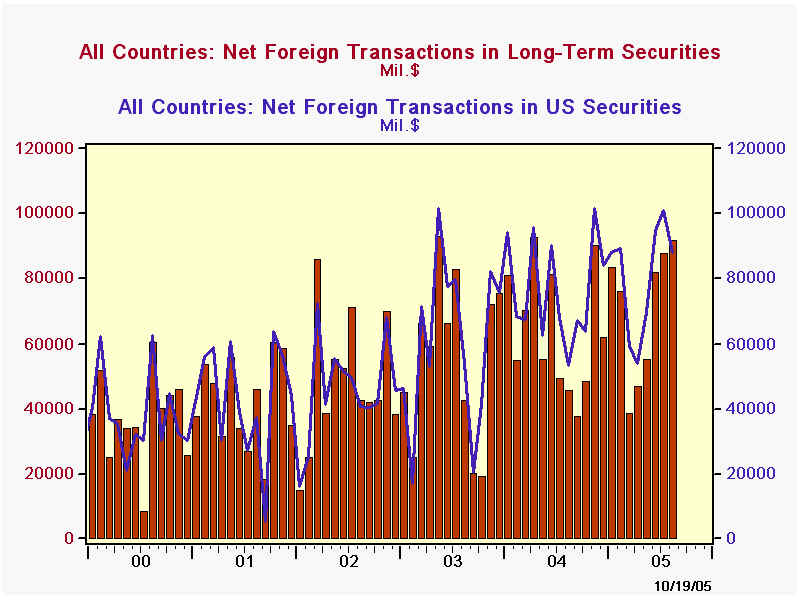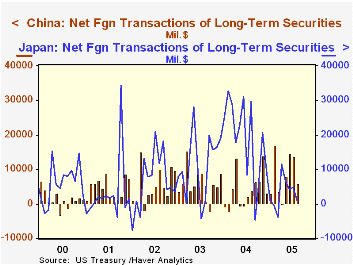 Global| Oct 19 2005
Global| Oct 19 2005Foreign Buying of Securities in US Markets 3rd Largest in August
Summary
Yesterday's report by the US Treasury of net purchases of securities by foreign investors indicated the third largest monthly amount ever in August, $91.3 billion. This followed two other sizable amounts, $87.5 billion in July and [...]

Yesterday's report by the US Treasury of net purchases of securities by foreign investors indicated the third largest monthly amount ever in August, $91.3 billion. This followed two other sizable amounts, $87.5 billion in July and $81.8 billion in June, making a record large three-month total, $260.6 billion, nearly $20 billion more than the prior record cumulative volume in July 2003.
In one sense, the August data are quirky and may not be sustained. The big total resulted from enormous net purchases of foreign bonds in US markets. Although partly offset by sales of foreign equities, the foreign investor activity in "Yankee" bonds and stocks swung to $3.4 billion in net purchases after 17 consecutive months of net sales.The spurt in foreign bond acquisition to $17 billion is far out of line with prior experience, so it will be interesting to see whether it continues or is quickly reversed.Otherwise, transactions in US securities actually moderated a bit in August. They totaled $87.8 billion, down from $101.2 billion in July. Purchases of federal agencies, so-called "GSEs" (government-sponsored enterprises) dropped back, while corporate bond buying picked up and Treasury purchases continue near their 12-month average of $25.3 billion.
Among countries, that swing in foreign securities apparently came from UK investors. It's important to point out here that these Treasury data represent transactions with the first non-US counterparty, regardless of the nationality of the final owner or seller. Since London is a major global financial center, it could well be investors from elsewhere -- perhaps the Middle East -- who moved out of foreign stocks and into bonds that trade in US markets.China's participation in US markets decreased to $5.7 billion in net purchases in August, but $13.8 billion in July and $14.7 billion in June made the largest two-month period by far; China's activity is quite erratic, and the let-up in August is actually fairly moderate compared with a sharp saw-tooth pattern that is frequently in evidence. Japan's net investments, by contrast, have slowed markedly the last several months after a large increase in 2004 and were only $1.2 billion in August.
| Net Foreign Purchases of Securities in US Markets (Billions US$) | Aug 2005 | July 2005 | June 2005 | Last 12 Months' Average | Monthly Average|||
|---|---|---|---|---|---|---|---|
| 2004 | 2003 | 2002 | |||||
| Total | 91.3 | 87.5 | 81.8 | 66.3 | 63.6 | 55.3 | 47.9 |
| Treasuries | 28.1 | 28.5 | 15.8 | 25.3 | 29.3 | 22.0 | 10.0 |
| Federal Agencies (mostly "GSEs") | 15.6 | 37.8 | 20.3 | 19.8 | 18.9 | 13.0 | 16.3 |
| US Corporate Bonds | 40.3 | 24.9 | 54.4 | 29.6 | 25.1 | 22.1 | 15.2 |
| US Corporate Stocks | 3.8 | 10.0 | 4.4 | 5.1 | 2.4 | 2.9 | 4.2 |
| Foreign Bonds | 17.0 | -5.1 | -1.2 | -4.3 | -5.6 | 2.7 | 2.4 |
| Foreign Stocks | -13.5 | -8.7 | -11.8 | -9.4 | -7.1 | -7.4 | -0.1 |
Carol Stone, CBE
AuthorMore in Author Profile »Carol Stone, CBE came to Haver Analytics in 2003 following more than 35 years as a financial market economist at major Wall Street financial institutions, most especially Merrill Lynch and Nomura Securities. She had broad experience in analysis and forecasting of flow-of-funds accounts, the federal budget and Federal Reserve operations. At Nomura Securities, among other duties, she developed various indicator forecasting tools and edited a daily global publication produced in London and New York for readers in Tokyo. At Haver Analytics, Carol was a member of the Research Department, aiding database managers with research and documentation efforts, as well as posting commentary on select economic reports. In addition, she conducted Ways-of-the-World, a blog on economic issues for an Episcopal-Church-affiliated website, The Geranium Farm. During her career, Carol served as an officer of the Money Marketeers and the Downtown Economists Club. She had a PhD from NYU's Stern School of Business. She lived in Brooklyn, New York, and had a weekend home on Long Island.





